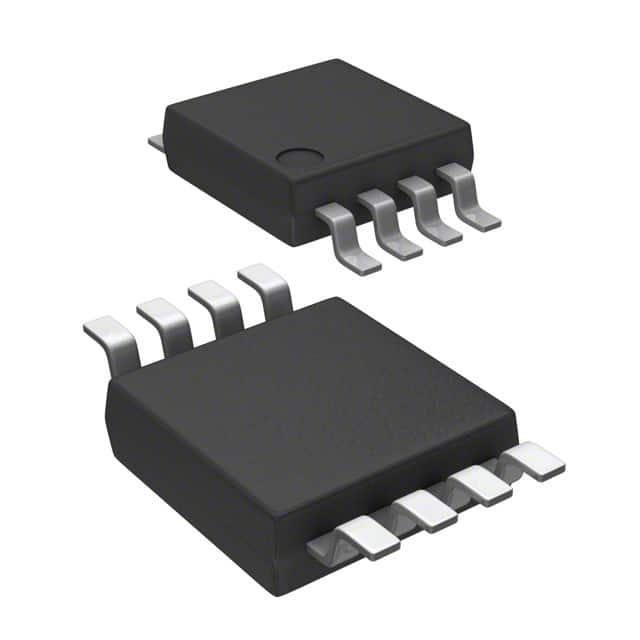MCP4162-103E/MS
Introduction
The MCP4162-103E/MS is a digital potentiometer belonging to the category of integrated circuits. It is commonly used in electronic devices and systems for its unique characteristics and versatile applications. This entry provides an overview of the MCP4162-103E/MS, including its basic information, specifications, pin configuration, functional features, advantages and disadvantages, working principles, application field plans, and alternative models.
Basic Information Overview
- Category: Integrated Circuits
- Use: The MCP4162-103E/MS is used as a digital potentiometer in various electronic applications.
- Characteristics: It offers digital control, non-volatile memory, low power consumption, and high resolution.
- Package: The MCP4162-103E/MS is available in a small outline package (MSOP) for easy integration into circuit designs.
- Essence: Its essence lies in providing a digitally controlled variable resistance for circuit adjustments.
- Packaging/Quantity: The MCP4162-103E/MS is typically packaged in reels with a quantity specified by the manufacturer.
Specifications
- Resolution: 8-bit
- Interface: SPI (Serial Peripheral Interface)
- Operating Voltage: 2.7V to 5.5V
- Temperature Range: -40°C to +125°C
- Endurance: 1,000,000 write cycles
- Wiper Current: 1mA maximum
Detailed Pin Configuration
The MCP4162-103E/MS has a standard 8-pin configuration: 1. VSS (Ground) 2. A (Terminal A of Potentiometer) 3. B (Terminal B of Potentiometer) 4. W (Wiper Terminal of Potentiometer) 5. CS (Chip Select) 6. SCK (Serial Clock) 7. SI (Serial Input) 8. VDD (Power Supply)
Functional Features
- Digital Control: Allows precise adjustment of resistance through digital signals.
- Non-Volatile Memory: Retains settings even when power is removed.
- Low Power Consumption: Ideal for battery-powered devices.
- High Resolution: Provides fine-grained control over resistance values.
Advantages and Disadvantages
Advantages
- Precise digital control
- Non-volatile memory retention
- Low power consumption
- High resolution
Disadvantages
- Limited endurance compared to mechanical potentiometers
- Susceptible to electromagnetic interference in some environments
Working Principles
The MCP4162-103E/MS operates by using digital signals to control the position of the wiper terminal, effectively changing the resistance between terminals A and B. This digital potentiometer utilizes non-volatile memory to retain its settings, ensuring consistent performance across power cycles.
Detailed Application Field Plans
The MCP4162-103E/MS finds extensive use in various applications, including: - Audio equipment for volume control - Instrumentation and measurement devices for calibration - Industrial automation for parameter adjustments - Consumer electronics for user interface controls
Detailed and Complete Alternative Models
Some alternative models to the MCP4162-103E/MS include: - MCP4131: 7-bit digital potentiometer with similar features - AD8403: 8-bit digital potentiometer with parallel interface - MAX5481: 10-bit digital potentiometer with I2C interface
In conclusion, the MCP4162-103E/MS digital potentiometer offers precise digital control, non-volatile memory, and low power consumption, making it suitable for a wide range of electronic applications.
Word Count: 495
قم بإدراج 10 أسئلة وإجابات شائعة تتعلق بتطبيق MCP4162-103E/MS في الحلول التقنية
What is the MCP4162-103E/MS?
The MCP4162-103E/MS is a digital potentiometer, also known as a digital variable resistor, that can be used to digitally control resistance in electronic circuits.What is the typical application of MCP4162-103E/MS?
The MCP4162-103E/MS is commonly used in applications where precise and digitally controlled resistance adjustments are required, such as in audio equipment, instrumentation, and industrial control systems.What is the resistance range of MCP4162-103E/MS?
The MCP4162-103E/MS has a resistance range of 10 kΩ, which makes it suitable for a wide range of applications requiring variable resistance.How is the MCP4162-103E/MS controlled?
The MCP4162-103E/MS can be controlled using a microcontroller or other digital interface, allowing for precise and programmable resistance adjustments.What is the power supply voltage range for MCP4162-103E/MS?
The MCP4162-103E/MS operates within a wide power supply voltage range of 2.7V to 5.5V, making it compatible with various electronic systems.Can the MCP4162-103E/MS be used in automotive applications?
Yes, the MCP4162-103E/MS is suitable for automotive applications, providing digitally controlled resistance adjustments in automotive electronics and control systems.Is the MCP4162-103E/MS suitable for battery-powered devices?
Yes, the low power consumption and wide voltage range of the MCP4162-103E/MS make it well-suited for use in battery-powered devices and portable electronics.What is the resolution of the MCP4162-103E/MS?
The MCP4162-103E/MS offers 8-bit resolution, allowing for fine-grained control over resistance adjustments.Can the MCP4162-103E/MS be used in audio volume control applications?
Yes, the MCP4162-103E/MS is commonly used in audio volume control circuits, providing precise and digitally controlled volume adjustments.Are there any special considerations for integrating the MCP4162-103E/MS into a design?
When integrating the MCP4162-103E/MS into a design, it's important to consider proper decoupling, signal routing, and compatibility with the digital control interface to ensure optimal performance.


